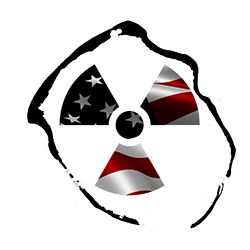The Glow By Nighters
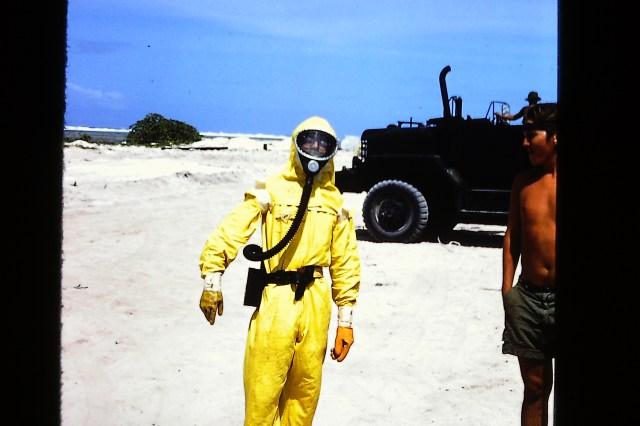
It would be impossible to tell the sorry tale of the US’s misadventures in the Marshall Islands without introducing the Lojwa Animals and the Atomic Clean-Up Vets of Enewetak. Between 1946 and 1958 the US detonated 67 nuclear weapons on Bikini and Enewetak, averaged out, the equivalent of a weapon like that dropped on Hiroshima, every single day for twelve straight years. Testing began on Enewetak in 1948. In the next ten years, there would be 43 separate blasts, just on this atoll, 22 in 1958 alone, as the pace of weapons design sped up and the production of plutonium multiplied rapidly. The US was also spurred on by the prospect of a testing moratorium. The rush was on to produce ever more powerful, efficient but, most importantly, deliverable weapons. Enewetak rapidly became the most radioactive place on Earth. The Nevada Test Site was a garden party by comparison. These are the men who lived, ate and worked in that environment; these are The Glow By Nighters.

When the Chernobyl power station blew it’s reactor apart in 1986, spreading radiation over much of Russia, Europe, and Scandinavia, it was considered to be the worst accident of its kind in history. What few realize is that Chernobyl pails into utter insignificance in comparison to the accumulated fallout of all the tests in the Marshalls. Nobody had bothered to assemble a record of fallout amounts in the RMI, and certainly not to release them to the public. The tests were conducted at this location, in the far Western Pacific, specifically because it was so removed from other centers of civilization, out of sight and beyond most people’s caring.
Studies by the CDC and others have suggested that Chernobyl would have to rip itself apart a staggering three thousand times over in order to even come close to the accumulated contamination on these atolls. The 15 megaton Castle Bravo test alone irreversibly contaminated Bikini and spread radiation to as many as 28 other atolls, to one degree or another. Bikini is still uninhabitable as we speak, though fruitless attempts have been made to resettle it. Many radioactive isotopes have half-lives measured in just a few decades; plutonium, on the other hand, lingers for a full 240,000 years. We can take another look in 242017 AD.
In 1972, the US decided to try and remediate the damage done to Enewetak. A radiological study had been performed by an AEC team on the entire atoll and found that at least six of the northern islands were highly contaminated, including Lojwa, where as many as 2600 of the remediation crews were to be stationed as well as Enjebi, Aomon, Runit and Bijire.
To the immediate north and south of Lojwa were islands that had seen extensive weapons testing. Regardless, in 1977 a labor force of 8033 army, navy, air force servicemen and civilians began to arrive on the atoll. Many were ‘voluntold’ in forces vernacular; they had little choice but to go where they were told. According to their testimony to me, it seems that few, if any of these servicemen were ever informed of exactly what it was they were moving around; as far as they were concerned, it was just another construction project of the massive scale many of them were used to, albeit one with a difference, on a remote coral atoll in the Pacific. It seemed like a decent gig, without much danger, reasonable downtime, and in a beautiful, tropical location, with a picture postcard island lagoon and palm trees. The men were simply told not to eat any of the local seafood or vegetation on any of the islands. And that appears to be the extent of their indoctrination to the most dangerous place on Earth. According to many of them, the canteens routinely ignored the order regarding the local fish. On the lighter side, some of the bulldozer drivers could chase the many resident sharks along the beach for recreation.
Boken, Enjebi, Aomon and Runit all saw multiple bomb tests. Where the label ‘Mike (S)’ can be seen in the map above, there used to be an island called Elgulab. It was vaporized by that weapon, the first true hydrogen bomb. Three subsequent tests were performed in the 1 1/4-mile wide crater left where the island used to be. These were the largest of the islands in the atoll. Runit saw a total of 18 smaller tests on land and in the lagoon nearby. The majority of the men were housed on the main island of Enewetak, to the South. They were the ones who ran support for the operations on Lojwa and Runit, running LCU’s, landing craft much like those made famous during WWII, to the Northern islands and bringing soil, sand, and radioactive debris back South to Runit. Incidentally, the same LCU’s used to carry contaminated soil also carried the personnel from island to island. It was literally impossible to get to any spot that was not contaminated with radiation. Men based on Lojwa, worked, ate and slept just 200 ft from Bijire, site of one test and less than a 1000 ft from Aomon, where there were four tests. Lojwa is about 4 miles from Runit. The men there were surrounded by, and worked on, islands that had been pounded by multiple nuclear detonations.

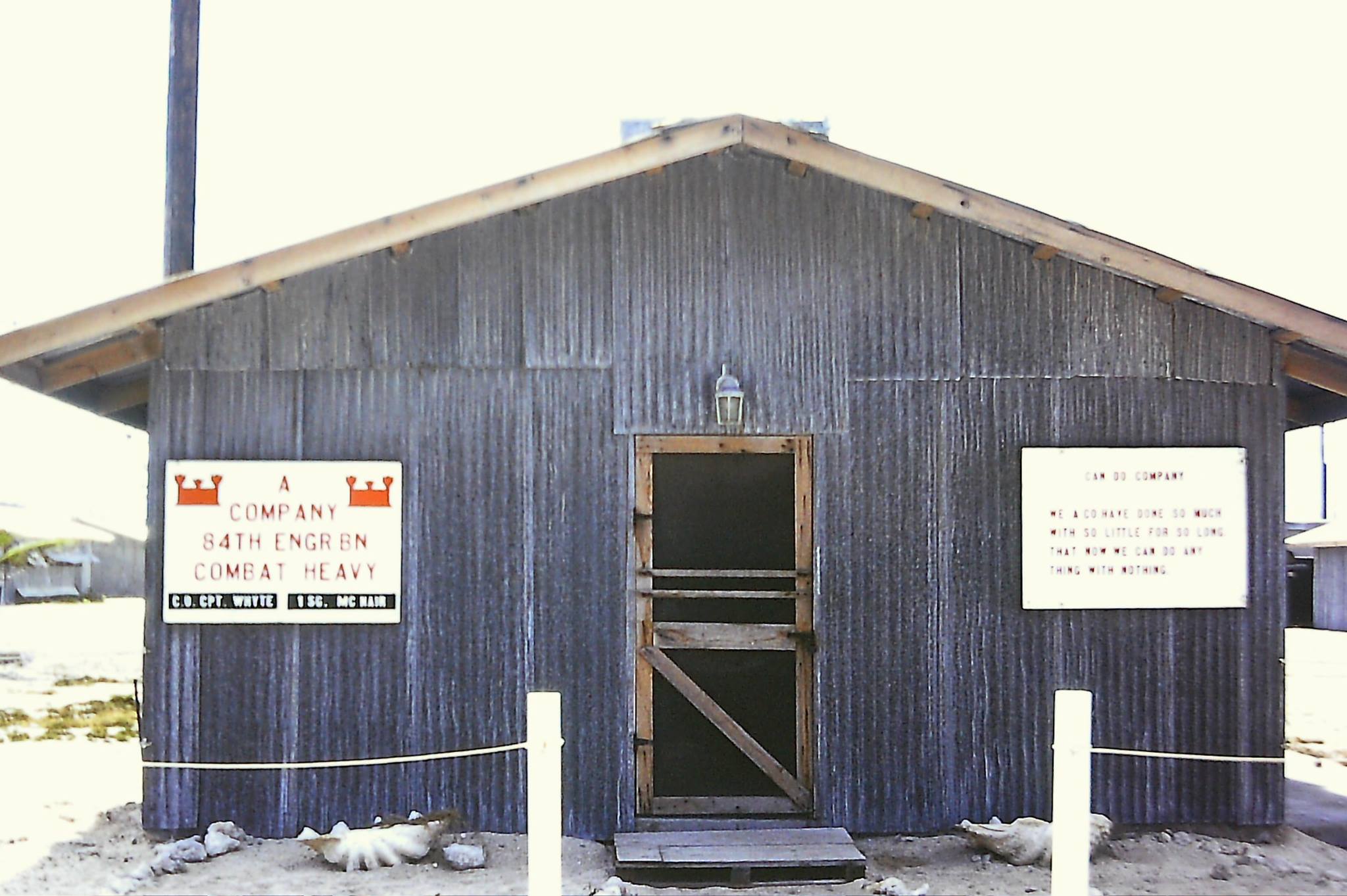
Can Do Company – the sign on the right reads: We have done so much with so little for so long that now we can do any thing with nothing.
It seems that the decision was made to station the men on Lojwa, (code name Ursula) known to be highly contaminated – and kept there – so that they did not track plutonium to the cleaner islands in the South of the atoll. A 1981 DNA follow-up study, post clean-up, omits Lojwa entirely from the narrative of contaminated islands, this despite the fact that the official record states that no effort was made to clean the islands at all in the years between 1972 and 1977, the year crews got to the island to pour concrete for the Quonset hut foundations, the building where hundreds of men would live in the three years encompassing the clean-up. The aggregate for the cement that formed the base of the Quonset huts came from Enjebi, incidentally one of the most radioactive of the northern islands, due to the fact that it had seen so many tests. No remediation was performed on Lojwa whatsoever, that has been recorded and yet, it is stated in official documents, that raw plutonium particles were found there and on Runit. Runit is of little surprise as it was the site of 18 tests, both on-island and in the immediately surrounding waters. Two of those tests were fizzles, bombs that failed to go critical and just spewed raw, unburnt plutonium over the landscape. These are the worst result possible as they obviously spread the most radiation. It would appear that the men housed on Lojwa were swimming in radioactivity, day and night.
A few of the men say they were issued bright yellow hazmat ‘banana suits’ at the very beginning. Most report that they never saw them. Regardless, no-one had thought to test the suits in the heat of the tropics. They proved to be impossible to work in and quickly vanished, just disappeared, with no viable replacement.
Harry Daniel was B Company XO of the team tasked with cleaning all the northern islands of radioactive soil and debris and then bring it to Runit, to be put in a large crater left behind after a small weapons test. A mammoth task in itself. Daniel says he never even saw a RAD badge, despite the fact that Lojwa was a controlled area, managed by field radiation support teams (FRST) whose sole task was to ascertain the exposure of every single man working on the island. Those that ever got them, after July of 1977, said they never worked as designed. Many of the vets believe that, as a result, they were given an ‘administrative’ dose of 00.0 on the back end. Was this a fudge by the authorities – registering zero when there were, in fact, enormous amounts of radiation in the environment? The badges were also damaged easily, rendering them useless. New badges that did work didn’t arrive until February of 1979 when the job was almost over. Many of the men report being run over by radiation detectors during their work shifts, which would go haywire, only to be told the detectors were malfunctioning.
‘During early months of [the] program, the film badge damage created problems of coming up with an administrative dose for posting to 114l’s (Record of Occupational Exposure to Ionizing Radiation). The period 17 June 1977 thru 20 November 1977, was first calculated by the Office of the Surgeon General and then posted to 114l’s. All the administrative doses for the same period were recalculated by FCDNA using island access information. This created a requirement to remake numerous 1141’s.’
Major General Grayson D. Tate, Jr. I Commander, Field Command, Defense Nuclear Agency, Fact Book dated, 25-29 MAY 1979.
Not a few of the vets have a problem with the term ‘recalculated’. How was it recalculated, and who decided what the end result would be?
In some spots on the Atoll were mysterious, unexplained plutonium ‘crypts’, concrete structures that none of the cleanup crews knew anything about. Who built them and why? What exactly was 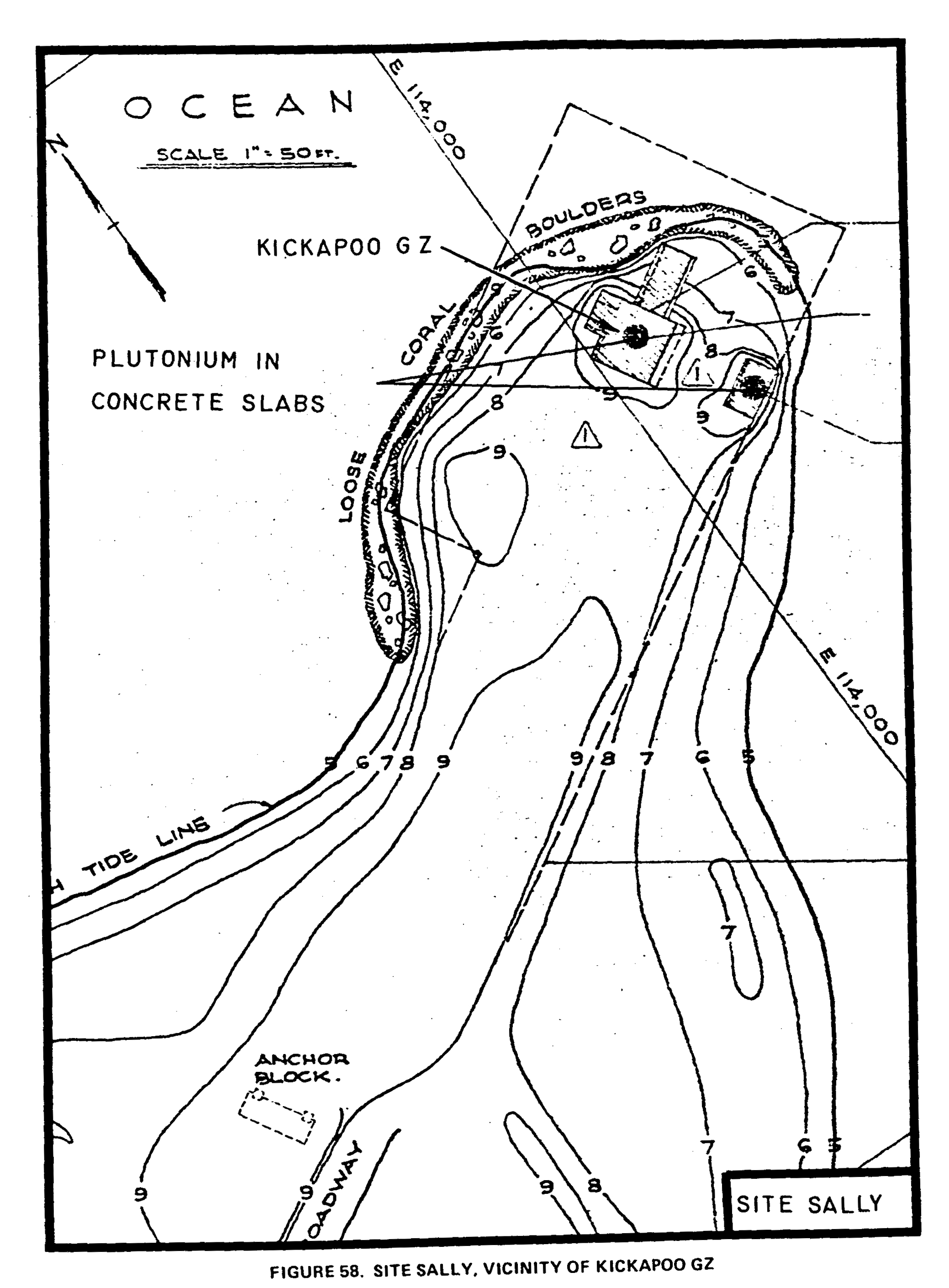 in them? Who put them there? No-one knew. The following is from a DNA document dated 1958:
in them? Who put them there? No-one knew. The following is from a DNA document dated 1958:
‘Apparently, some collection and burial of concrete contaminated with alpha-emitting materials had also begun before HARDTACK, although it is not mentioned in the base support contractor’s report for HARDTACK. Investigators for a defense-related program at Enewetak report (Reference D.3.) that in 1972 they found five 20- x 20-foot (6.1- x 6.1-meter) concrete slabs covering “‘(1.2-meter) 4 foot deep crypts on Aomon bearing the following notice and date:
ALPHA RADIATION DO NOT EXCAVATE
THIS 3 INCH THICK CONCRETE SLAB COVERS PLUTONIUM CONTAMINATED CONCRETE DEBRIS
AEC APR 11 1957
The [Redwing] KICKAPOO test in 1956 was held at Aomon and did spread alpha-emitting contamination. Whether these crypts contained only material from Aomon, or from other islands as well, is not stated in the source.’
In short, a great deal was totally unknown about the disposition of the land, where extreme radiological hotspots were. Tremendous amounts of metal wreckage left over from the tests were just left rusting in the tropical sun. Much of this was the metal infrastructure for the many towers built to house the weapons. It was all massively irradiated.
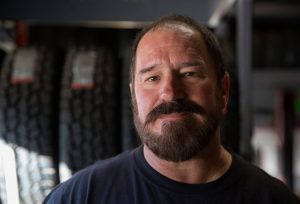
In May of 1977, Paul Laird was one of an advanced party, among the first to arrive since the testing ended, sent to Enewetak to clear the islands of vegetation so a base could be constructed. He was a bulldozer driver on Lojwa, readying the island for the arrival of a lot more men. He notices that the sand on Runit was almost as fine as talc. This is what coral looks like after being pulverized by atomic weapons. None of the dozer crews are aware of what it is they’re moving but Laing says he suspected that it wasn’t good and so wrapped a tee shirt around his head. He remembers asking repeatedly for any kind of protective mask, even a paper one, only to be told they were on back-order. He drove an open cab bulldozer with what appears to be highly radioactive coral dust and probably raw plutonium blowing in his face for six months. In the years since returning to the States, he has had kidney cancer, bladder cancer, digestive problems, precancerous polyps, strange rashes, hypertension, an odd mass removed from behind his ear, one very similar from his back, diabetes type two, skeletal and joint problems and chronic muscle pain. A lot of the men who were on Enewetak have decreased bone mass as well as numerous cancers. Two bulldozer drivers that Laird knew well have since passed away.
Laird’s experience with cancer would mirror almost exactly those of the men of 2nd Marine Division who entered Nagasaki in the weeks after the destruction of that city, to perform cleanup duties, driving bulldozers and removing shattered buildings. Lyman Quigley was one such marine who had seen duty in some of the bloodiest battles in the Pacific, and who, in the years following his time in Nagasaki, would suffer through cancer, bleeding in his lungs, weeping skin sores, chronic, unremitting pain, anomalous growths and no fewer than 5 heart attacks. Thirty years after his time in Japan, Quigley managed to track down fifteen of his old buddies from their time in Nagasaki. All of them had the same symptoms. Of the 15, six had had heart attacks before reaching 50. Four of those did not survive. For these men, the greatest adversary they ever faced was their own government and, specifically, the Veterans Administration and Defence Nuclear Agency. To them, any atomic vet with medical problems was the enemy. A 1977 CDC study of atomic vets from a 1957 Nevada test code-named Smoky, when extrapolated, suggested that many hundreds of troops involved in the wider testing had probably died as a direct result of the experiments they were pressed into. The VA continued to deny all claims. Laird lost his own battle with cancer in March, 2019, contracted during his time in Enewetak.
Bulldozing sand on Runit. All the bulldozers were highly contaminated but kept working anyway 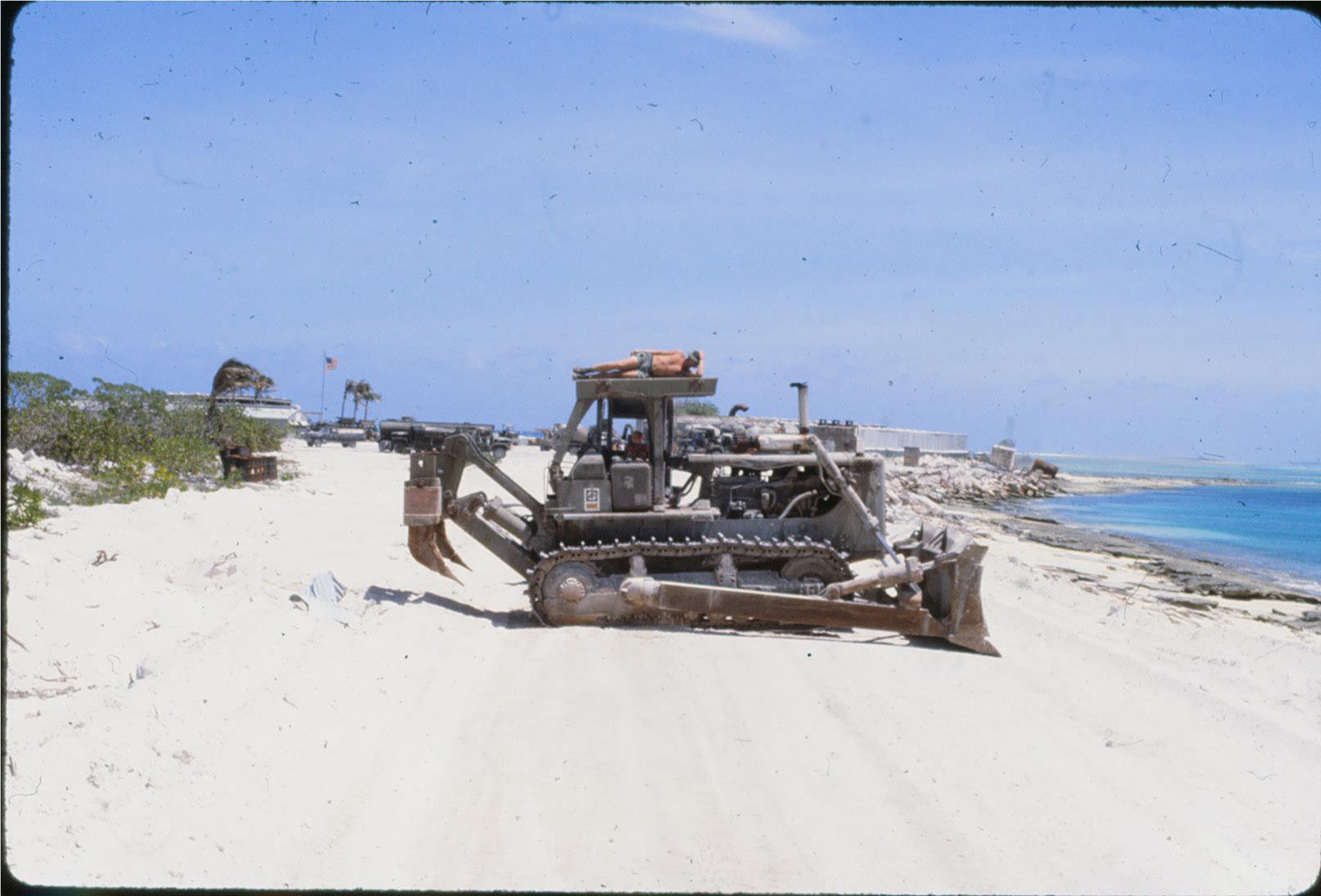
What records there are of the years of atomic testing show that clean-up between blasts was, at best, an afterthought, haphazard and frequently undocumented. It was generally only performed if the next test in the same spot demanded it. Little effort was afforded in finding out just how contaminated the islands were until well after the tests were finished. It was assumed that the Northern islands were the worst off because that’s where most of the tests had been carried out. For the next three years, 1977-1980, waves of these men scraped the worst affected islands of their topsoil, sand and any metallic debris, 110,000 cubic yards of it, enough to fill a football stadium. It was all gathered together and dumped inside a crater made by a small device code-named Cactus, on the northern end of Runit Island. The sand and dirt was mixed with Portland cement at a specially constructed mixing plant on the island, to stabilize it, and then a massive concrete dome, comprised of 357 18″ thick trapezoidal panels, was erected over the pile.
John Laramie remembers, ‘I was promoted to E-5 the first week I was there because of TIS. Our platoon Sgt. thought it would be better to have an E-5 as Squad leader. So pay-wise it was good for me. I never once pulled rank on anyone and got along just fine for the six months I was there. We were Lojwa Animals and most every day I drove a 20-ton dump [truck] and also helped our squad picking up debris and filling the bucket loader that would follow us around. When it was full I would bring the truck around and the debris would be dumped in my truck…… and you all know where it went from there. Yup. Out to a barge in the lagoon, where it was off-loaded and then dumped overboard and into the lagoon. And months later this would be job security for another beach detail… and so it went. We worked on a number of the islands, but it does seem we spent a lot of time on Janet (Enjebi Island). I remember well the big water hole (not crater) on Janet we would swim in at lunch break. I would park the 20-ton right up close to the huge coral reef hole so We could use the headache board over the cab as a diving platform. When the tide was out and we had done a good walk around checking to be sure no sharks got left in with the out going tide We were good to go.’
‘Before the sand went to the batch plant it went through a shaker that would shake loose and throw out debris such as tree roots, unexploded ordinance from WW II (grenades, mines, ammunition, etc..) then it would travel by conveyor belt to the batch plant. All of the ordinance was considered to be live given the degradation of 33-36 years since the 1944 Battle for Enewetak. The EOD Teams would gather and detonate all the ordnance after the rest of us left Runit. The dump trucks would deliver the soil and debris from Enjebi, dump it, then it was dumped into the shaker hopper by a front end loader, shaken as it went up the belt to the concrete hopper, mixed with cement then into a concrete truck and onto the Cactus crater. So yes, everything went into the shaker hopper. I remember being amazed that nothing ever exploded when it was tossed!’
David Roach drove a cement truck on the run between the cement plant and the Cactus crater:
Pete Moreno ‘I worked picking up debris from the huge amount of military equipment that was destroyed in the test. From the low tide mark to the high tide mark. Also, the reefs around the islands were covered in old munitions and unexploded munitions. Tons of it! We dragged the metal debris up to the beach by hand. Jagged, rusted and radioactive.’
An event that everyone on the atoll remembers and talks of is the loss of the Lojwa camp doctor, Capt. Jon Flores and PFC Tim Jarvis, who set out for a lazy Friday afternoon sailing trip on December 29th, 1978, in the lagoon near Bijire, and simply vanished. It’s assumed that they were somehow swept out to sea. A massive sea and air search effort, covering the entire atoll, lagoon and the ocean downwind, lasted for four days but found nothing. It was called off on January 3rd, as Typhoon Alice was bearing down on Enewetak. Almost everyone on Lojwa was evacuated to Enewetak, leaving just a small recovery detail. When the typhoon hit the island, surf went from ocean-side, clear across the island and into the lagoon. The diver equipment locker was destroyed and had to be rebuilt. Power went down along with all radio communications. An unsubstantiated rumor had the boat found a month later and a thousand miles away with two partial bodies in it.
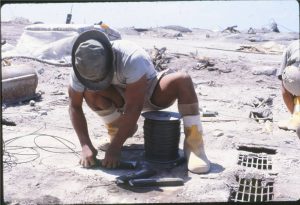 Planting TNT
Planting TNT
Victor Czarnecki drove a concrete mixing truck from the plant that was erected on Runit, to the Cactus crater, non-stop, dawn to dusk.
‘My name is Victor Czarnecki.The cycle was like this! You had guys who would take TNT out and blow up part of the island to get the rock! Then take it to a rock crusher and then to the batch plant! Then, to one side we had guys that did nothing but open bags of concrete all day long by hand which came to the batch plant and we would mix it all together and load it into the trucks! Then they would drive like hell to the pit (Cactus) and hope they could get it out of the truck before it got hard!!! And if by chance the truck broke down someone would have to go in with a jackhammer and clean it out! This could happen just about every day! This was 6 days a week, 12 hrs a day and that was the life of a Runit Rat.’
Dept of Energy -Enewetak Radiological Support Project – Dated 1982
‘The dominant long-lived radionuclides of concern from nuclear testing are plutonium and americium which are health hazards if inhaled, ingested, or introduced to the body as through a skin wound; and cesium and strontium which are absorbed by plant roots and may be incorporated in the parts of the plant used by man as a source of food. Man’s body, in turn, incorporates the cesium and strontium in certain parts where the possibility of deleterious effects is enhanced. The half-life of plutonium-239 is nearly 25,000 years, essentially forever in terms of human time scales. On the brighter side, the half-lives of cesium-137 and strontium-90 are less than 30 years—a short enough period for activity levels to reduce to one-fourth the initial value in one human lifetime. Cesium and strontium generated by the first nuclear tests at Enewetak have already decayed through one half-life, but for practical purposes the inventory of plutonium-239 is unchanged. If measurement of the level of activity of (plutonium) 239 were accurate to within one percent, it would take 250 years of natural radioactive decay for the change to be measurable. (This degree of accuracy is realistically achievable in the austere conditions of a field laboratory; higher accuracy is attainable in more ideal laboratory environments.)’
The Rock Crusher
Major General Grayson D. Tate, Jr. I Commander, Field Command, Defense Nuclear Agency, Fact Book, 25-29th MAY 1979
The site is the Aomon plutonium crypt.
‘Air sampling also followed the established EAI: one air sampler at the hotline, one at the Crypt during excavation or soil movement, and one at the beach stockpile site when soil movement occurred there. No significant airborne activity has been found. Handling of debris by personnel (wearing gloves), rather than by machine, was kept to a minimum because of the likelihood that a person could be cut and the wound become contaminated. The debris was found to be plated with plutonium and coated with an asphalt-like substance which easily flakes off. These highly contaminated flakes fell into the Crypt water and thus the Crypt soil was declared to be contaminated and designated for removal to Cactus Crater whether or not actual measurements of transuranic contamination had been performed by the DOE/ERSP. Finally, rubber boots were required within the Crypt area near excavated soil and debris because the wet conditions in the Crypt enhanced the chances for contamination of footgear. However, significant levels of personnel contamination were never observed.’
 It’s hard to parse statements like this with the recollections of the men themselves. To begin with, it’s all but inconceivable that there was no ‘airborne activity’. The surface layer on all the atolls was a toxic stew of radioactive isotopes mingled with very fine, irradiated sand. The oral testimony of the men themselves tells a starkly different tale. To begin with, they were rarely in anything more than shorts and boots. No masks of any kind and gloves were often not available either. While contamination may not have been observed, it was all but impossible to avoid as the entire working environment was indeed contaminated; the men were constantly swimming in it.
It’s hard to parse statements like this with the recollections of the men themselves. To begin with, it’s all but inconceivable that there was no ‘airborne activity’. The surface layer on all the atolls was a toxic stew of radioactive isotopes mingled with very fine, irradiated sand. The oral testimony of the men themselves tells a starkly different tale. To begin with, they were rarely in anything more than shorts and boots. No masks of any kind and gloves were often not available either. While contamination may not have been observed, it was all but impossible to avoid as the entire working environment was indeed contaminated; the men were constantly swimming in it.

In the photo to the right, the white circle is the Cactus dome. The blue circle above it, in the water, is the crater left by the 40 kiloton Redwing Lacrosse test of May 4th, 1956. There were eighteen tests on Runit or in the water surrounding it.
If the islanders themselves were treated as guinea pigs under the nuclear weapons development program, then the vets have to be thought of as victims in the same scenario. They have been fighting a protracted battle in congress, in order to have themselves recognized as “at risk”, due to the lingering effects of radiation poisoning. Many of them have had life-altering surgery of the type that is only associated with heavy exposure to radioactive environments. Thyroid cancer, bowel cancer, pancreatic cancer, liver cancer, testicular cancer, cancer of the brain, cancer of the esophagus, lung cancer, cancer of the intestines, leukemia, cataracts; all these and more, in profusion. A great many of these vets left us way too young. The first was Bruce Millspaw, from Provo, Utah, who died of cancer just four years after leaving Enewetak at age 24. He was a Mormon, non-smoker, who did not drink. His wife was denied recovery of the $15000 medical costs they incurred. The survivors, because they are survivors, are all too often suffering from one or more on that list. I have befriended many of these amazing men through their Facebook page. I am proud to be an honorary Animal. This is their story.
There are three acts floating through Congress that would see the Vets getting the at-risk status and allow them the same reparations that are afforded the atomic vets who actually participated in the testing and were directly affected by fallout. The bills are HR 3870, HR 5980 and HR 632.
This is what the vets have been up against (via Wikipedia). It’s essentially a get-out-of-jail-free card, exonerating the Pentagon from any liability…for anything:
Feres v. United States, 340 U.S. 135 (1950), combined three pending federal cases for a hearing in certiorari (writ or order by which a higher court reviews a decision of a lower court) in which the Supreme Court ruled that the United States is not liable under the Federal Tort Claims Act for injuries to members of the armed forces sustained while on active duty and not on furlough and resulting from the negligence of others in the armed forces.
This essentially allows the government to do whatever it deems necessary to the populace and not be penalized for it. It covers a multitude of sins.
As of the beginning of the year, of the 8033 men who were on Enewetak in these years, just 444 remain.
